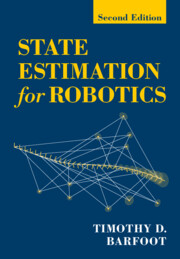Book contents
- Frontmatter
- Contents
- Preface for the First Edition
- Preface for the Second Edition
- Acronyms and Abbreviations
- Notation
- 1 Introduction
- Part I Estimation Machinery
- Part II Three-Dimensional Machinery
- Part III Applications
- 9 Pose Estimation Problems
- 10 Pose-and-Point Estimation Problems
- 11 Continuous-Time Estimation
- Part IV Appendices
- References
- Index
11 - Continuous-Time Estimation
from Part III - Applications
Published online by Cambridge University Press: 11 January 2024
- Frontmatter
- Contents
- Preface for the First Edition
- Preface for the Second Edition
- Acronyms and Abbreviations
- Notation
- 1 Introduction
- Part I Estimation Machinery
- Part II Three-Dimensional Machinery
- Part III Applications
- 9 Pose Estimation Problems
- 10 Pose-and-Point Estimation Problems
- 11 Continuous-Time Estimation
- Part IV Appendices
- References
- Index
Summary
The final technical chapter returns to the idea of representing a robot trajectory as a continuous function of time, only now in three-dimensional space where the robot may translate and rotate. We provide a method to adapt our earlier continuous-time trajectory estimation to Lie groups that is practical and efficient. The chapter serves as a final example of pulling together many of the key ingredients of the book into a single problem: continuous time estimation as Gaussian process regression, Lie groups to handle rotations, and simultaneous localization and mapping.
Information
- Type
- Chapter
- Information
- State Estimation for RoboticsSecond Edition, pp. 418 - 432Publisher: Cambridge University PressPrint publication year: 2024
